Understanding the blockchain "bridge": How to break the trust boundary of the Crypto world?
Original title: "Understanding the Blockchain "Bridge": How to Break the Trust Boundary of the Crypto World? "
Original Author: Arjun Chand
Original Compilation: South Wind, Unitimes
The encryption ecosystem in the past ten years Rapid development in the middle of the year. Since the release of the Bitcoin white paper in 2008, there has been tremendous innovation in the crypto space and widespread adoption, almost mainstream. While every year in crypto is unique, 2021 has transformed the ecosystem and fueled excitement about a seemingly limitless future in crypto.
2021 is the year of the L1 (Layer 1) blockchain, which has led many to predict that the future of the crypto space will be multi-chain, unlike many Different from the "winner takes all" stance people took before the rise of these L1 blockchains. However, with the dramatic increase in the number and size of different blockchain ecosystems, critical infrastructure is now required to connect them. This is where the blockchain “bridge” comes in.
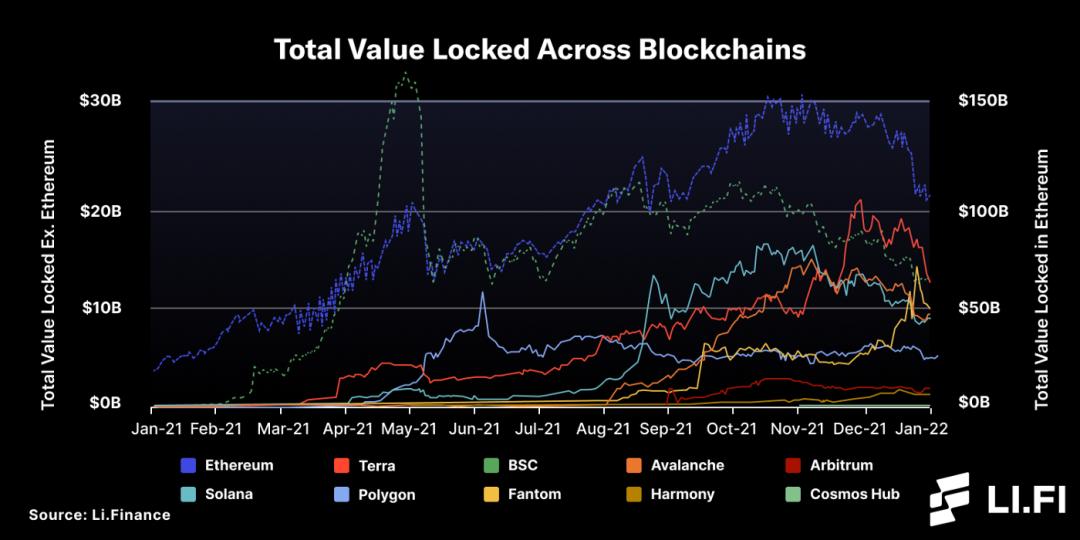
In this article, we will discuss:
- What is Blockchain "bridge"?
- Why do we have different types of "bridges"?
- How do we classify these "bridges"?
Let's find out!
What is a blockchain "bridge"?
Blockchain "bridges" work similarly to real bridges in the real world. However, a "bridge" in the crypto space is not connecting physical locations, but connecting two different blockchain networks. This connection is important because without a blockchain "bridge," blockchains would be in siled environments and unable to communicate with each other. This is because each blockchain network has its own set of rules, governance mechanisms, native assets, and data that are incompatible with other blockchains. However, with a "bridge" between two blockchains, it is possible to transfer encrypted assets and arbitrary data between blockchain networks. Therefore, the "bridge" is the key to interoperability in the crypto ecosystem and is very necessary to make different blockchain networks compatible with each other.
Let's give an example:
Alice has ETH on the Ethereum mainnet, but Want to use these ETHs on the Avalanche chain. These two blockchains have their own protocols, rules, communities, and consensus mechanisms, so interoperability between them is not possible. In this case, something needs to be in the middle and provide a way to bring information from the Ethereum mainnet to the Avalanche chain. To this end, Alice will likely transfer assets across a blockchain "bridge" to securely transfer ETH from the Ethereum mainnet to the Avalanche chain. Through this "bridge", Alice can convert ETH on Ethereum to wETH on the Avalanche chain. As shown below:
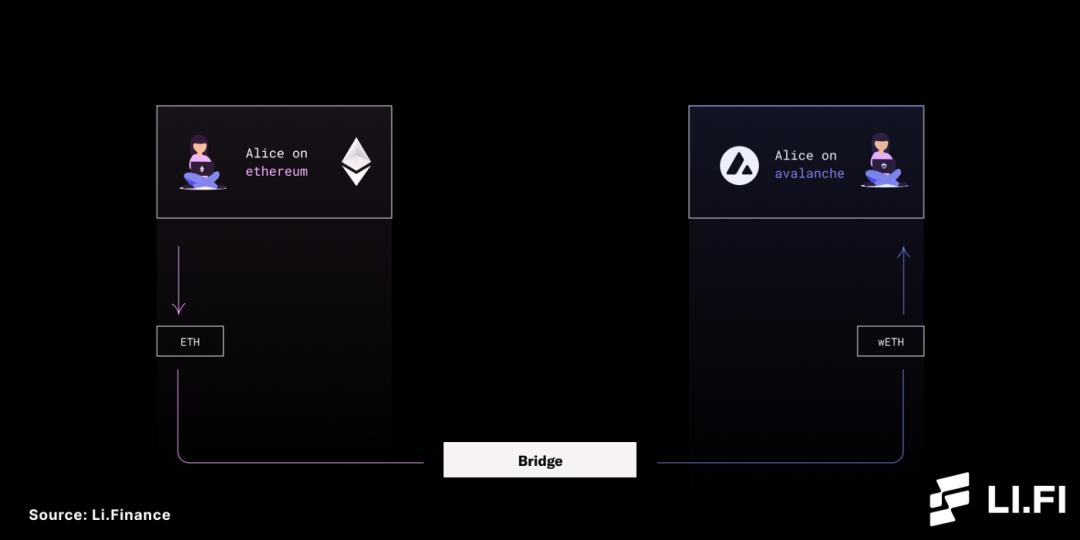
Above: The process of bridging ETH from the Ethereum mainnet to the Avalanche chain (converting ETH to wETH)
< /p>
Why are there different types of "bridges"?
Blockchain "bridges" enable communication between different blockchains. And, like complex math problems, when you look at the different bridging solutions in the crypto ecosystem, you realize that there is not just one way to achieve communication between blockchains. Different blockchain "bridges" have different designs and have their own unique advantages and disadvantages, so there are many choices when it comes to which "bridge" to use for communication between two blockchain networks. Let's dig a little deeper into how this communication works.
A "bridge" works by establishing a communication channel between two blockchains. In an ideal world, blockchains would communicate with each other; in reality, this is impossible because one blockchain does not store the state of another blockchain.
Let's take an example:
A dApp on Ethereum (decentralized application) wants to communicate with a dApp on the Solana chain. Due to the trust boundaries between Ethereum and Solana, they cannot simply communicate with each other. These trust boundaries include, but are not limited to:
- Ethereum and Solana do not know each other.
- These two chains can only know what happened on their own chain, but not what happened outside the chain.
For both blockchains, receiving messages from each other is like interacting with the outside world, which they know nothing about. Therefore, no trust can be established to verify these messages.
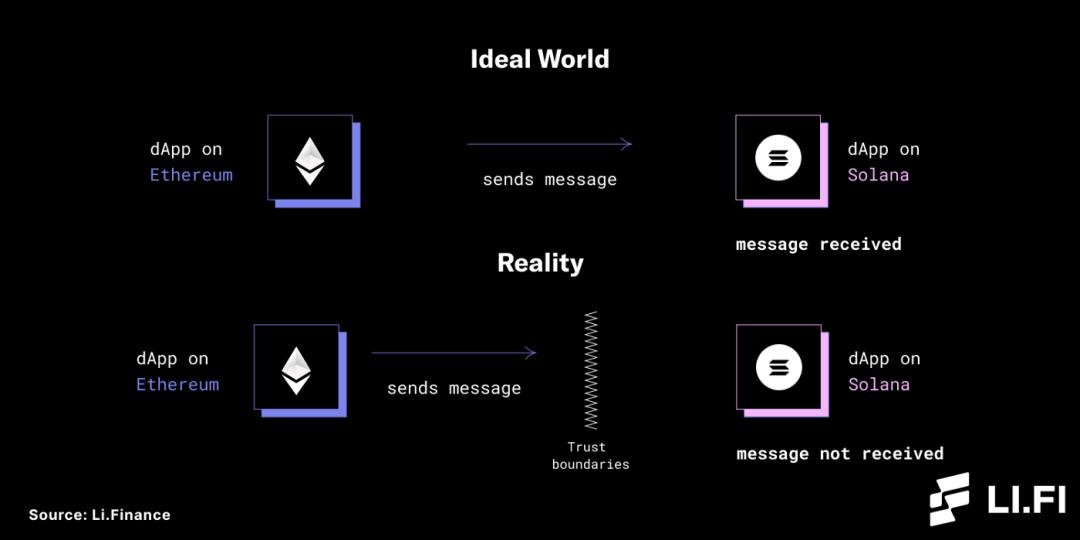
In addition , the blockchain can only send messages in one direction. That is, there is only one-way communication in a channel: one blockchain can send a message to another blockchain on a channel, but the other blockchain cannot rely on the same channel to reply to the message and confirm receipt. to the message.
In order to build trust between blockchains and make two-way communication possible, we need something in the middle, something that can bridge between these blockchains Bridge stuff. This is the role of the blockchain "bridge", which can not only transfer messages, data and resources between different blockchains, but also transfer assets across chains. This changes things so that blockchains are no longer limited to one-way communication, as "bridges" enable blockchains to communicate back and forth with other blockchains.
Blockchain "bridges" use different mechanisms or actors that act as validators between blockchains to enable communication and Overcome trust boundaries. Communication between blockchains would not be possible without these off-chain actors.
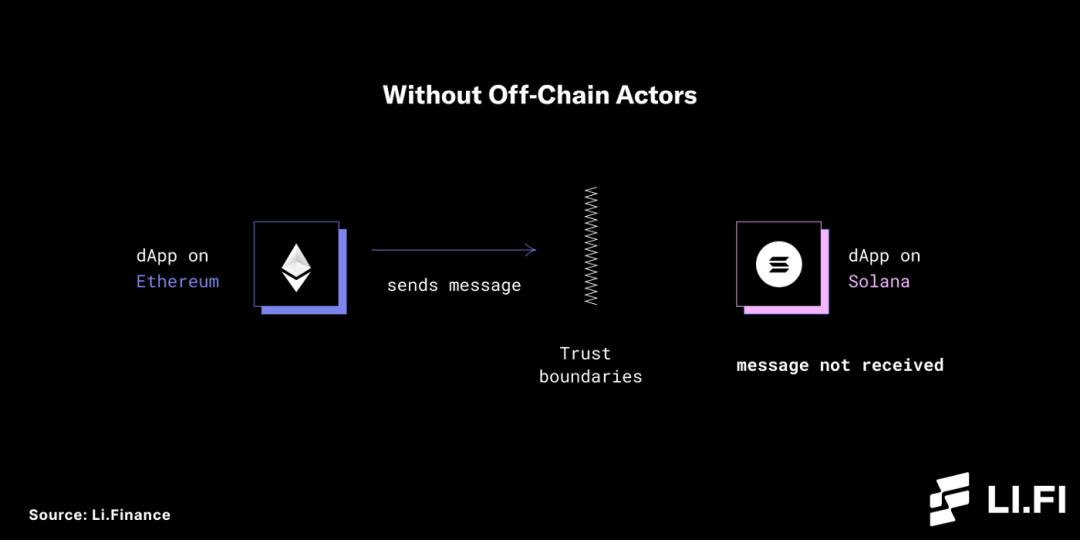
However, with these off-chain participants acting as "middlemen" between the two blockchains, trust boundaries can be overcome and communication becomes possible.
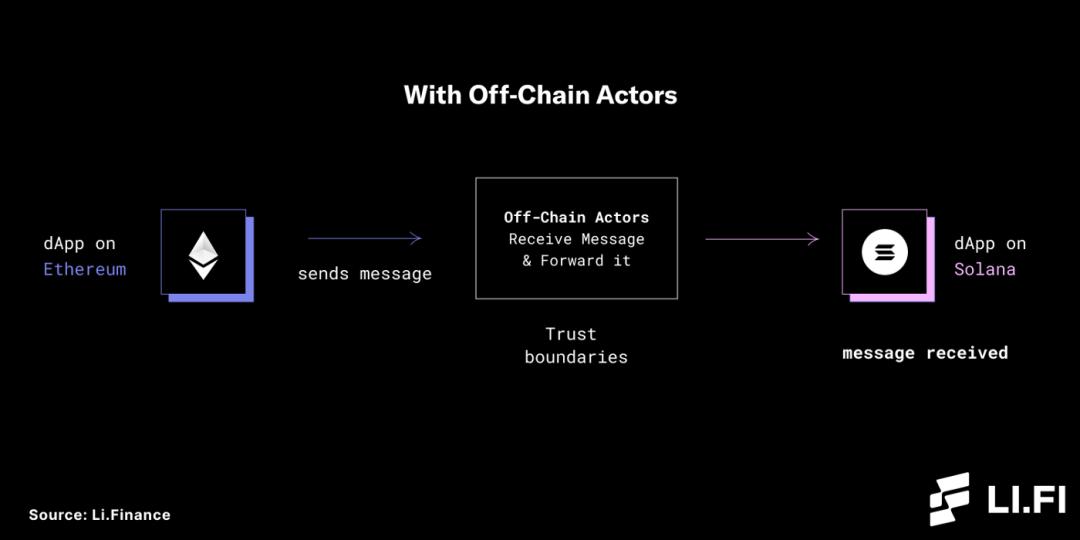
The role of the verifier is the main difference in how the bridge works. Essentially, some "bridges" use a trusted system, while others use a trustless system of verifiers. Additionally, we see different types of blockchain “bridge” designs due to the “interoperability trilemma” in the crypto ecosystem. The interoperability trilemma states that "an interoperability protocol or "bridge" can only have two of the following three properties:
- No need for trust ( Trustlessness): has the same security as the underlying blockchain;
-Extensibility: can be supported on any blockchain;
-universal (Generalizability): Ability to handle arbitrary cross-chain data.
Different blockchain "bridge" proposals focus on different of the three factors listed above and have their own advantages and trade-offs. Therefore, different "bridge" designs have unique value propositions. The following figure classifies different "bridges" according to their trustlessness, scalability and universality:
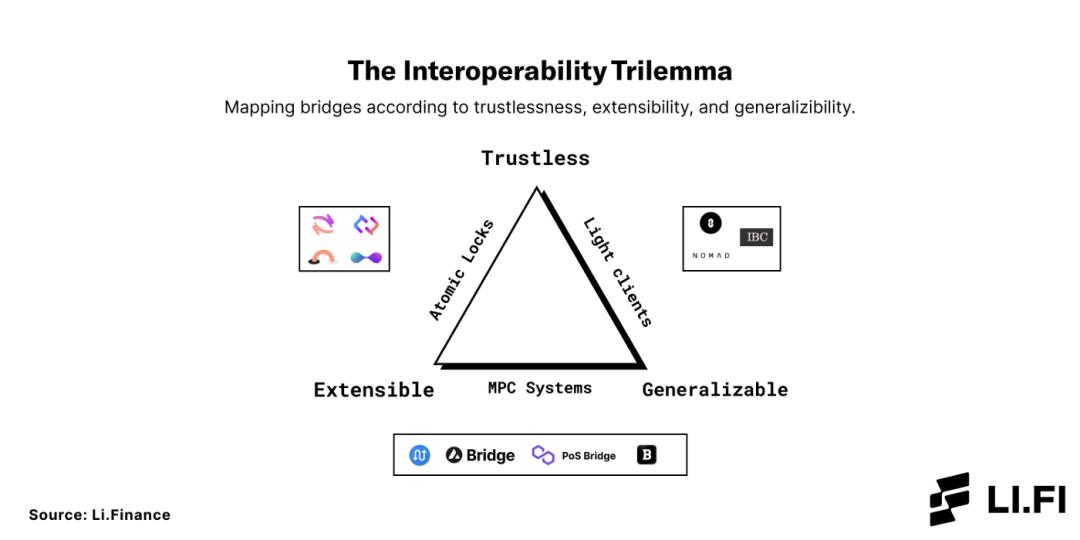
In addition, the blockchain bridge solution Arjun Bhuptani, the founder of Connext, also divides the "bridge" into native verification system (that is, the verifier of the blockchain itself is responsible for verifying cross-chain data) and external verification system (that is, using A set of external verifiers to relay cross-chain data) and a local verification system (ie only the parties involved in a particular cross-chain interaction will verify that interaction).
The above points explain why we have different blockchain "bridge" designs. However, in general, we see different types of "bridges" because of the objects they connect and the main use cases. We will explain this further below.
Based on the working principle of "bridge" to classify
Although all blockchains " The purpose of the "bridge" is the same (that is, to achieve communication between different blockchains), but their implementation methods are different. According to how they work, blockchain "bridges" can be roughly divided into:
- Trusted Bridges: These types of blocks Chain "bridges" use a central authority to operate. This type of blockchain bridge is called a "trusted "bridge" because users need to trust a third party (the central authority) to use the "bridge" and keep their funds. Examples of such bridges include multi-chain "bridges" and blockchain-specific "bridges", such as the Binance <> Ethereum Bridge.
- Trustless Bridges: These blockchain "bridges" eliminate the need for trusted third parties through the use of smart contracts and algorithms character of. They are called "trustless bridges" because they don't require users to trust a central authority to use the bridge. Therefore, the safety of the user's funds is always kept by the user. Examples of such bridges include Connext, cBridge, and Hop.
Example:
Suppose you are at an airport security checkpoint. There are two types of security checkpoints:
- Manual checkpoints: These are controlled and operated by airport officials and users must trust them to keep their Personal Information and Items.
- Self-service checkpoints: where machines are in charge and users are in control of their personal information and belongings at all times.
Manual checkpoints are the "bridge" of trust. This kind of checkpoint relies on a trusted third party, that is, official personnel to operate. Users must relinquish control of their own assets.
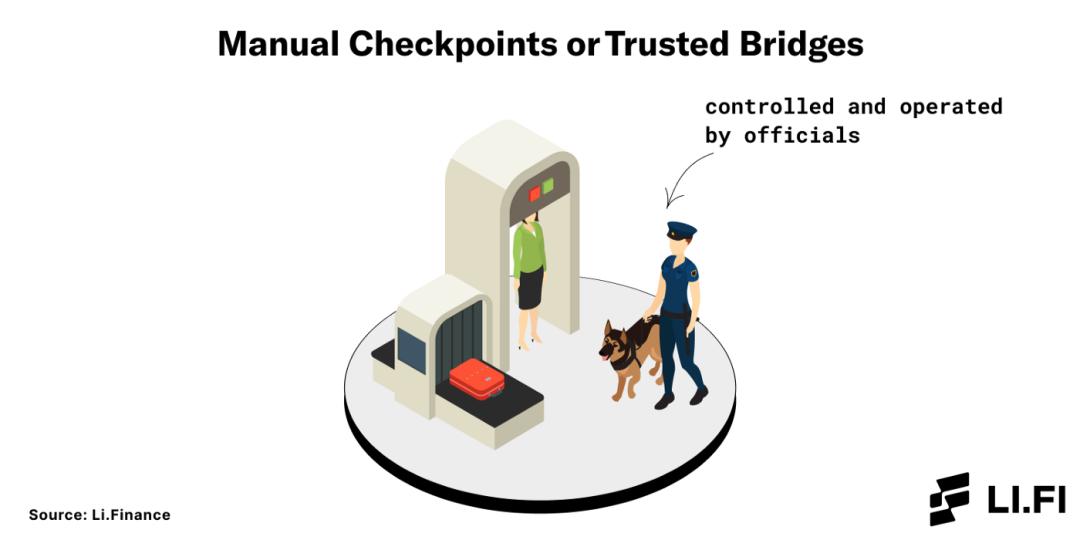
Self-service checkpoints are equivalent In the "bridge" that does not require trust. This checkpointing technique removes the role of officials, allowing users to retain control of their assets.
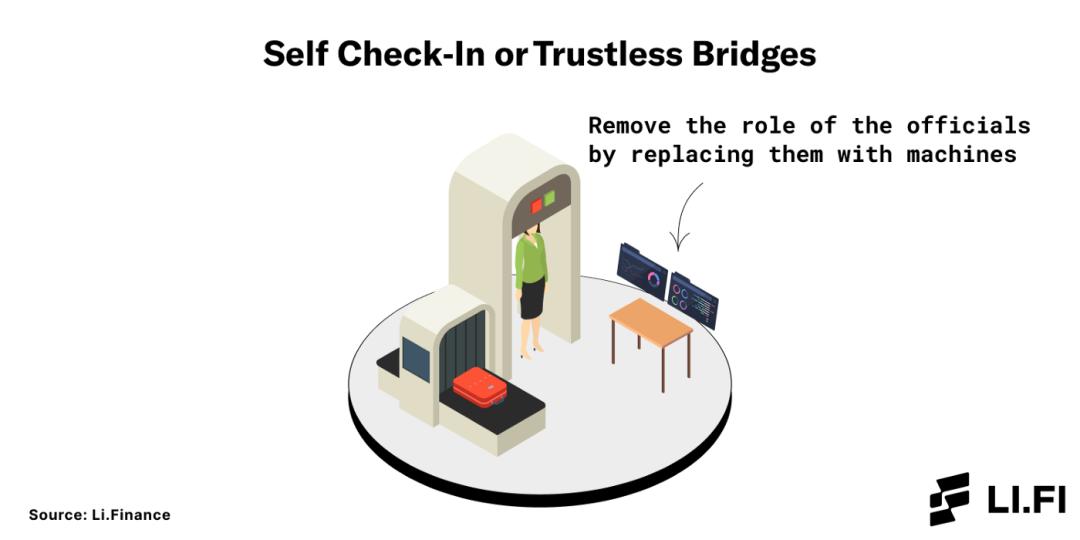
Based on "bridges"
Besides how they work, blockchain "bridges" can be divided into the following categories based on the objects they connect:
- L1 <> L1 Bridge: This type of "bridge" connects two different L1 blockchain networks. For example, the Avalanche Bridge connects the Ethereum network and the Avalanche chain.
- L1/L2 <> L2 Bridge: This type of "bridge" connects an L1 blockchain to an L2 network, or connects two different L2 network is connected. For example, Across is a bridge that connects Ethereum L1 with L2 networks such as Arbitrum and Optimism; Hop Protocol is a bridge that connects different L2 networks, and it can also be a bridge that connects Ethereum L1 and L2 networks.
For example:
Based on Dragonfly Capital managing partner Haseeb Qureshi’s blockchain Described as a mental model of cities, we can say that blockchain "bridges" are like roads connecting different cities. Depending on what these bridges connect, roads can be divided into the following categories:
- National Highways: These are the roads that connect all major cities.
- State Freeways: These are roads that connect important parts of a city.
The national highway is equivalent to "L1 <> L1 Bridge". If Ethereum is like New York City, and the Avalanche chain is like Chicago, then the Avalanche Bridge is the national highway connecting them.
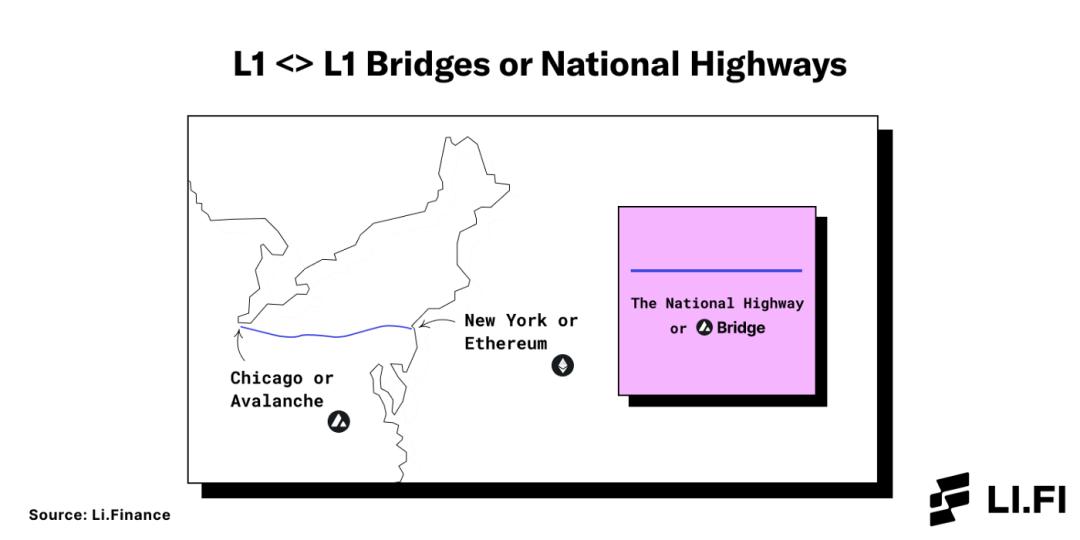
State highway is equivalent to Equivalent to "L1/L2 <> L2 Bridge". If L2 networks and Rollups (like Arbitrum and Optimism) are the two skyscrapers of Ethereum (NYC), then Hop Protocol is the intrastate highway connecting them.
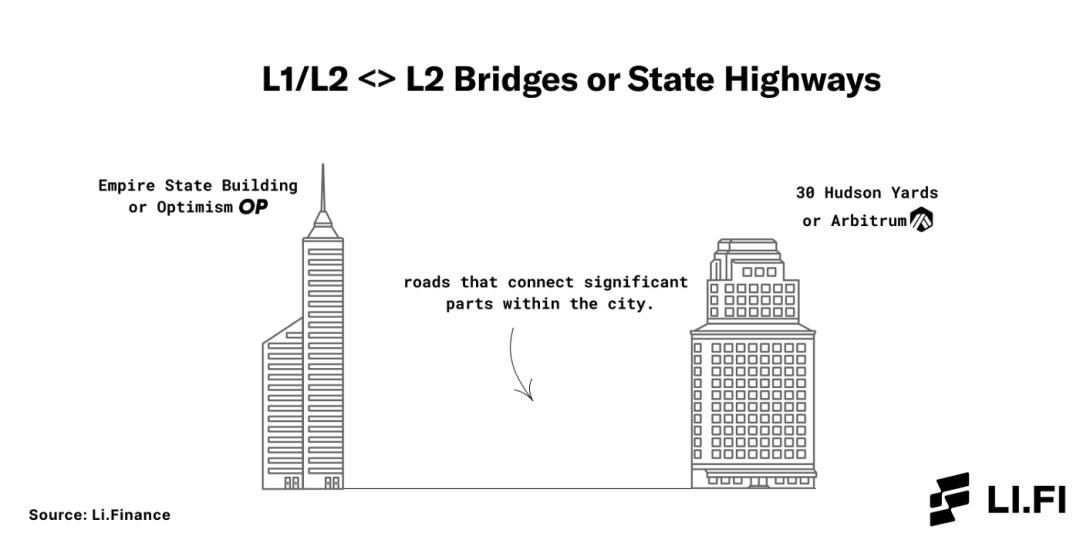
Based on the way of "bridge" transfer assets
We can also classify according to The mechanism used by blockchain "bridges" when transferring assets across chains to categorize them. In general, depending on how the blockchain "bridge" transfers assets, they can be grouped into the following categories:
- Locking & Minting: This category A blockchain "bridge" locks assets on the source chain and mints assets on the target chain. Examples include Polygon’s PoS Bridge, Avalanche Bridge (AB), Wrapped BTC (wBTC), and wMonero.
- Burn & Mint: This type of blockchain "bridge" burns assets on the source chain and mints assets on the target chain. Such as Hop Protocol and Across Protocol.
- Atomic Swaps (Atomic Swaps): This type of blockchain "bridge" will exchange assets on the source chain for assets on the target chain. In general, such "bridges" are trustless as they rely on self-executing smart contracts for asset swaps, thereby eliminating the need for trust in the "lock & mint" and "burn & mint" mechanisms third party needs. Such as cBridge and Connext.
For example:
Suppose you drive from city A to city B, the two The cities are connected by a bridge. When you arrive at the bridge and are about to leave city A for city B, you have 3 options to cross the bridge:
1. Take your The car is placed in a warehouse in city A, and in exchange, you get an identical car in city B. When you return to city A, you just need to return the car you got when you arrived in city B, and take back the car you originally had in city A. This is similar to the "lock & mint" mechanism used by blockchain "bridges". As shown below:
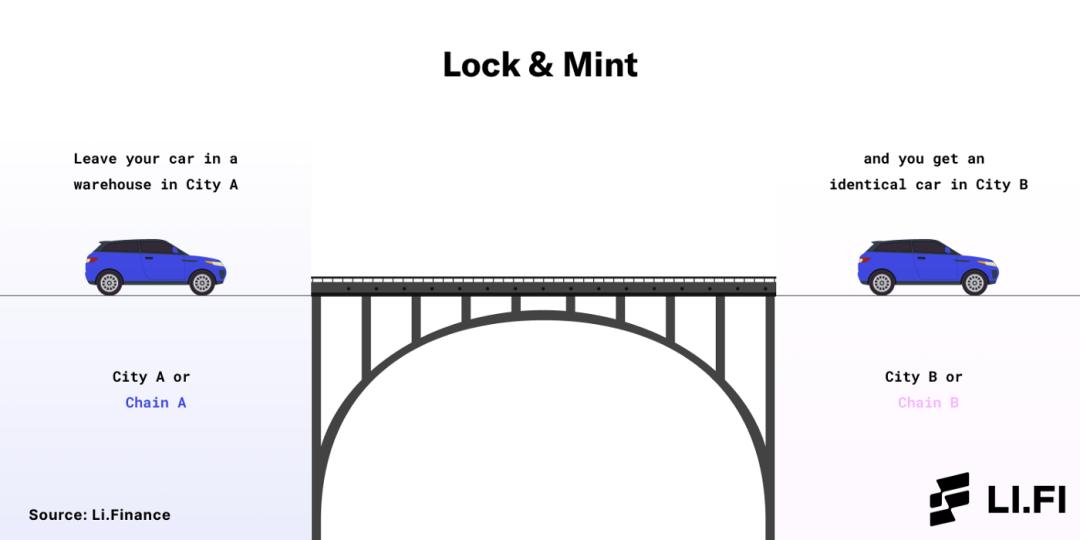
Above: "Bridge" using the "Lock & Cast" mechanism
2 , In order to leave city A, you must destroy your car, and in return, you will get an identical car in city B. When you return to city A, the same process will happen again: you have to destroy your car in city B, then you will get an identical car in city A. This is similar to the "burn & mint" mechanism used by blockchain "bridges". As shown below:
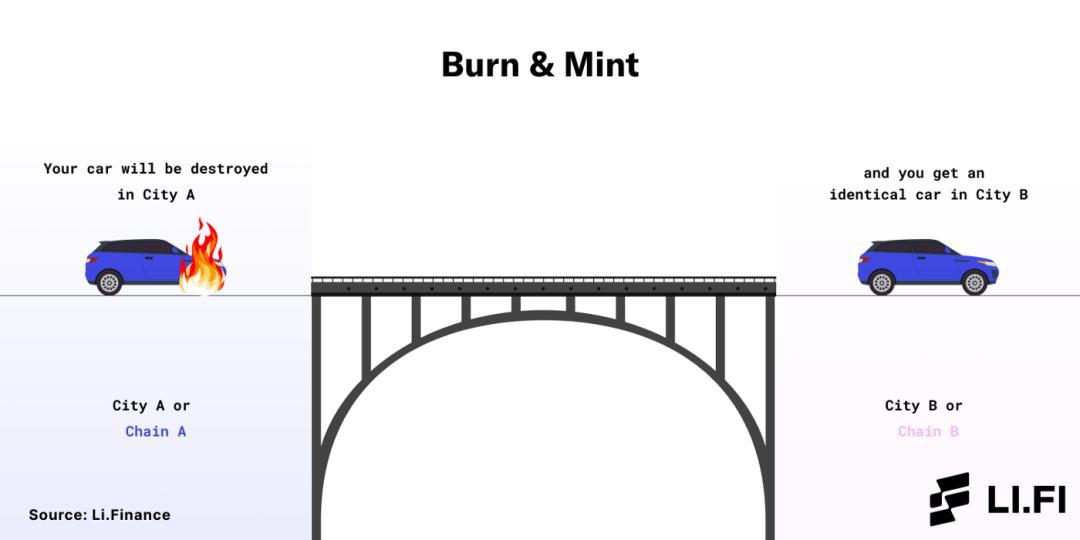
Above: "Bridge" using the "Destroy & Cast" mechanism
3 , Exchange your car in city A for another car in city B. When you return to city A, you can repeat the same process: exchange your car in city B for another car in city A. This is similar to the "atomic swap" mechanism used by blockchain "bridges". As shown below:
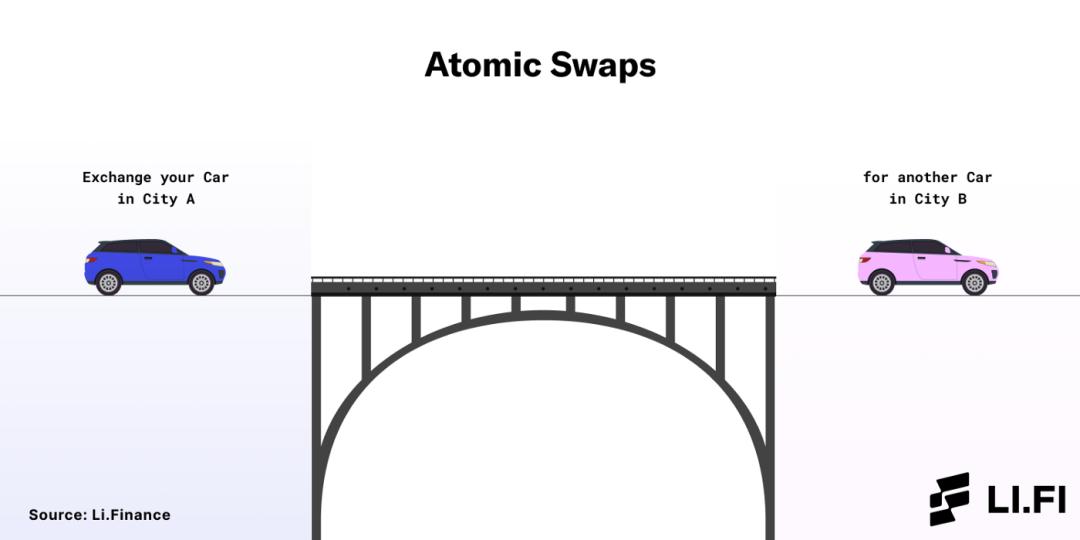
Above: "Bridge" using the "atomic swap" mechanism
Based on " Bridge" function to classify
The above classification distinguishes bridges very broadly. Things get complicated when we look at different "bridge" types and designs based on how they are used (aka what they do). According to their functions, "bridges" can be divided into the following categories:
- Chain-To-Chain Bridges: This type of "bridge ” is mainly used to support the movement of assets between two blockchains. Typically, such "bridges" use a "lock & cast" mechanism. For example: Polygon’s PoS Bridge (connecting Polygon and Ethereum), Binance <> Ethereum Bridge (connecting BSC and Ethereum), and Avalanche Bridge (connecting Avalanche and Ethereum).
- Multi-Chain Bridges: These "bridges" are designed to transfer assets across multiple blockchains. This "bridge" can be deployed to any L1 or L2 blockchain. For example: Connext and cBridge.
- Specialized Bridges (Specialized Bridges): This type of "bridge" is focused on a specific ecosystem and is designed to support the movement of assets between specific regions. Due to their specificity, these "bridges" often facilitate faster and cheaper cross-chain transactions. For example: Hop is a Rollup-to-Rollup bridge that enables asset transfers across the Ethereum mainnet and L2 network; Across focuses on fast and cheap asset transfers from L2 Rollups to the Ethereum mainnet.
- Wrapped Asset Bridges: These "bridges" are specifically designed to enable the transfer of non-native assets to different blockchains. This type of bridge works by creating wrapped assets on the target chain that represent assets on the source chain. For example: Wrapped BTC (wBTC), wMonero, etc.
- Data Specific Bridges: These "bridges" are specifically designed interoperability for transferring arbitrary data across multiple blockchains protocol. Typically, these protocols become the base layer for dApps, enabling dApps to achieve cross-chain composability. Examples: Celer's Inter-chain Message Framework, IBC, Nomad, and Data Movr.
- dApp Specific Bridges: These are not "bridges" from a purely technical standpoint. By connecting to different blockchains, these dApps build an ecosystem that allows value to be transferred across chains in a "bridge"-like manner. For example: Thorchain is a decentralized cross-chain AMM (Automated Market Maker) that provides cross-chain liquidity features to enable cross-chain asset exchange; other examples include Anyswap, Wanchain, and Synapse.
Summary
A "one size fits all" approach does not apply to blockchain "bridges" . There are no perfect solutions; there are only trade-offs for specific use cases - each "bridge" has its own strengths and weaknesses, and as we learned from the interoperability trilemma, all "bridges" must be Choose between trustworthiness, scalability, or ubiquity.
The multi-chain era has really arrived. Today, we have over 50 unique "bridges" criss-crossing the crypto world. Li.Finance is one of these "bridges". Our goal is to completely abstract the complex process of bridging assets. We want users and developers to focus on leveraging the limitless potential of blockchain technology, rather than getting bogged down in the details of deciphering the differences between various types of "bridges". We've partnered with the brightest minds to build the best abstraction and aggregation solutions available on the market.
***This article only represents the views of the original author and does not constitute any investment advice or suggestion.
Original link
Welcome to join the official BlockBeats community:
Telegram Subscription Group: https://t.me/theblockbeats
Telegram Discussion Group: https://t.me/BlockBeats_App
Official Twitter Account: https://twitter.com/BlockBeatsAsia


 Forum
Forum Finance
Finance
 Specials
Specials
 On-chain Eco
On-chain Eco
 Entry
Entry
 Podcasts
Podcasts
 Activities
Activities
 OPRR
OPRR







